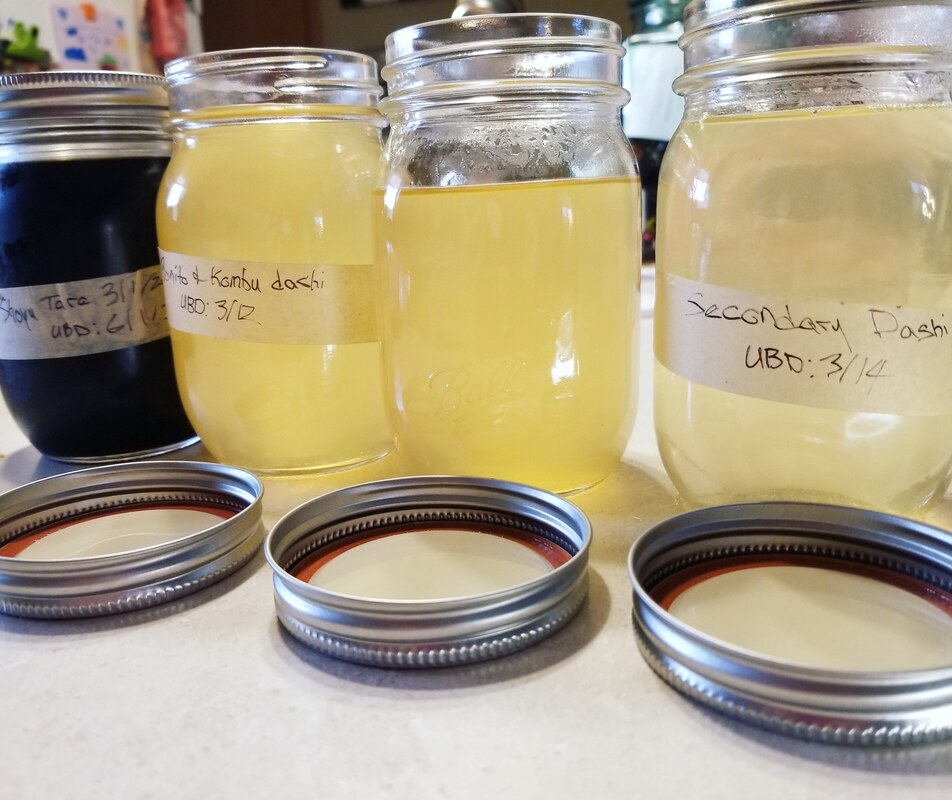|
This article was written before the COVID-19 pandemic began to spread aggressively within the United States. Please keep that in mind while reading.  Japanese Home Cooking relies upon a number of essential preparations that often need to be done ahead of your actual cook time, not the least of these is the quintessential Japanese stock, dashi. Sonoko Sakai discusses having these ready before you begin cooking, and I could not agree more with this statement after having had them available for my use during the regular weekday. As of writing this particular article, I’ve done nothing from this book but make milk bread and get these pantry ingredients ready. What I have already taken from the book, however, has made an abundant difference in my cooking. The beauty of these pantry ingredients is that they are usually quick to assemble for future use. The first of these that I took on was the sauce known as shoyu tare, a reduction of soy sauce, cane sugar, and mirin. It takes very little babysitting, and it keeps for longer than the dashi. After reducing the ingredients together, I stored it in a mason jar for whenever I would manage to get to actual recipes from the cookbook.
I had the flu in the second week of March which has hamstringed my cooking progress in this book significantly, but the shoyu is able to outlast any illness that sidelines the cook. I had it available for a weekend meal that I quickly prepared for my husband, adding it to a fried rice that apparently blew his mind. The seasoning it brings, while slightly sweet from the cane sugar, is much different than if you added a normal soy sauce. That alone is a point in favor of keeping the shoyu tare around even after I am finished with the book. Dashi, on the other hand, has sat in my fridge up until now with very little cooking having been done with it. It was, however, an interesting experience to bring it together. I don’t have any experience cooking with kombu kelp or kastuobushi, AKA bonito flakes. I had no concept of what dashi should taste like or the kind of flavor profiles that its base ingredients could create. I didn’t know that bonito flakes danced in hot water when you added them. All of this, I learned on dashi night. Sunday evening, I was finally fever free and felt like I would be safe cooking anything that would also be consumed by my husband that date or later. The bonito is time sensitive, and while I know the new bags I got wouldn’t go bad within the month, I didn’t want to make the mistake of letting them age in my cupboard like I had the bag that I purchased during the Momofuku debacle. I had high hopes for dashi. Sonoko Sakai includes a recipe for what she calls secondary dashi, a lighter and weaker dashi that’s made from the spent ingredients that you use to make your first stock. I created this one immediately after so I didn’t waste anything. This is something about cooking that I love. If an ingredient can be used more than once in order to reduce waste, I will advocate for that until the end of time. Knowing I could get three mason jars worth of stock out of the ingredients made me very happy. Dashi is a base ingredient in soups and noodle bowls of all kinds, some of which I intend to get to before the end of the month. It may very well require that I make a second batch if I continue to let my current batch sit in the fridge unattended. Given the current climate (the literal climate, as well as the political and health climates), food waste of any kind feels something like a special crime. Being in northern Wisconsin, I don’t anticipate that my husband and I will face any real quarantine, but my anxiety tells me not to waste anything-- just in case. This just in case mentality (AKA anxiety) has me turning to many recipes like these from within Japanese Home Cooking to make sure I have everything I could ever want or need-- whether it's to cook on a normal weeknight or to make a nice soup for my husband or myself if we do get sick. It’s a strange time to be living in, much less cooking in. Having this to fall back on when there is so much uncertainty is a small gift from the author to me. This is one of the things I love most about cookbooks. These very basic things that the author takes the time to teach a western audience about are perhaps some of the most valuable aspects of the book. I’ve heard of dashi all my life, but I never really understood how to make it. Some Japanese cooking programs online treat it like an instant stock, which I’m sure exists, but this is the way we can make it here. It’s a unique connection to a culture that has infiltrated our American cuisine in the form of sushi and now noodle shops.
2 Comments
2/16/2023 06:30:27 am
Look for the American Dental Association seal of approval to demonstrate that this product is safe.
Reply
Leave a Reply. |
The MissionAn idea born in Normal, Illinois, Eating Normal hopes to chronicle the eating Experiences of a Red bird. Pledge monthly to our patreon!
Or, you know, support the mission with caffeine! Buy me a coffee through Ko-Fi. Archives
May 2020
Categories
All
|
 RSS Feed
RSS Feed